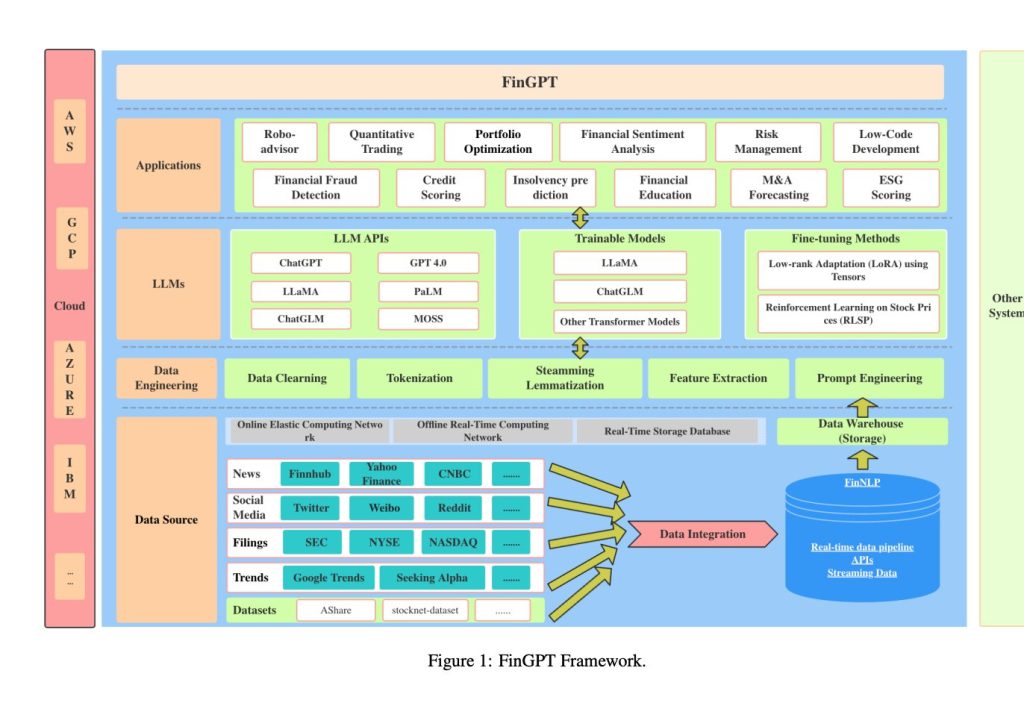FinGPT has emerged as a groundbreaking open-source platform designed to customize large language models (LLMs) specifically for the financial industry. This innovative framework is built on four core pillars: data sources, data engineering, large language models, and practical applications. Together, these elements ensure FinGPT’s functionality and adaptability to the ever-changing financial landscape.

At its heart, FinGPT prioritizes data, emphasizing the collection, cleansing, and preprocessing of financial information. This data-centric approach has resulted in a comprehensive framework that spans from data sourcing to engineering, model construction, and real-world implementation.
Adapting to Rapid Financial Changes
To address the dynamic nature of financial data, FinGPT employs cutting-edge techniques:
- Lightweight low-rank adaptation technology
- Reinforcement learning strategies
These advanced methods allow for precise model adjustments, enabling FinGPT to flexibly adapt to real-time fluctuations in financial markets.
Wide-Ranging Applications
The potential applications for FinGPT are vast and include:
- Intelligent financial advising
- Algorithmic trading
- Risk management
- And many more finance-specific use cases
FinGPT Ecosystem: A Comprehensive Suite of Financial AI Tools
FinGPT-Forecaster: Predicting Stock Price Trends
FinGPT-Forecaster is an innovative tool that analyzes recent market news and optional fundamental financial data related to a specified company. It evaluates positive developments and potential issues, then provides a forecast for the company’s stock price trend over the coming week, complete with an analytical summary.

This powerful forecasting capability demonstrates FinGPT’s ability to synthesize complex financial information and deliver actionable insights for investors and analysts.
FinGPT RAG: Enhanced Financial Sentiment Analysis
FinGPT RAG (Retrieval-Augmented Generation) represents a customized framework for financial sentiment analysis. By leveraging enhanced large language models and integrating external knowledge base retrieval, this tool ensures deeper information processing and contextual understanding. The result is a more precise and nuanced predictive analysis of financial sentiment.

FinNLP: A Comprehensive Platform for Financial NLP
FinNLP serves as a comprehensive platform for enthusiasts of financial LLMs and Natural Language Processing (NLP). It offers a complete training and fine-tuning pipeline specifically tailored for language models in the finance domain. This tool empowers researchers and practitioners to develop and refine AI models that can understand and generate finance-specific language with high accuracy.

FinGPT Benchmark: Optimizing Financial Language Models
The FinGPT development team has introduced a novel instruction tuning paradigm aimed at optimizing open-source large language models for the finance sector. This approach enhances the adaptability of these models to various financial datasets while facilitating cost-effective systematic benchmarking across specific tasks, multi-task scenarios, and zero-shot instruction tuning tasks.

FinGPT Datasets and Models
FinGPT provides a rich collection of financial datasets and pre-trained models, enabling researchers and practitioners to accelerate their work in financial AI. These resources cover a wide range of financial topics and data types, ensuring that users have access to high-quality, domain-specific information for training and fine-tuning their models.
| Datasets | Train Rows | Test Rows | Description |
|---|---|---|---|
| fingpt-sentiment-train | 76.8K | N/A | Sentiment Analysis Training Instructions |
| fingpt-finred | 27.6k | 5.11k | Financial Relation Extraction Instructions |
| fingpt-headline | 82.2k | 20.5k | Financial Headline Analysis Instructions |
| fingpt-ner | 511 | 98 | Financial Named-Entity Recognition Instructions |
| fingpt-fiqa_qa | 17.1k | N/A | Financial Q&A Instructions |
| fingpt-fineval | 1.06k | 265 | Chinese Multiple-Choice Questions Instructions |
Getting Started with FinGPT: A Practical Example
To illustrate the practical application of FinGPT, let’s walk through a sentiment analysis example using the FinGPT/fingpt-sentiment_llama2-13b_lora model.
Step 1: Install Dependencies
First, ensure you have the necessary libraries installed:
pip install transformers==4.32.0 peft==0.5.0
pip install sentencepiece accelerate torch peft datasets bitsandbytesStep 2: Load the Model and Run Inference
Here’s a Python script to perform sentiment analysis on financial news:
from transformers import AutoModel, AutoTokenizer, AutoModelForCausalLM, LlamaForCausalLM, LlamaTokenizerFast
from peft import PeftModel # 0.5.0
# Load Models
base_model = "NousResearch/Llama-2-13b-hf"
peft_model = "FinGPT/fingpt-sentiment_llama2-13b_lora"
tokenizer = LlamaTokenizerFast.from_pretrained(base_model, trust_remote_code=True)
tokenizer.pad_token = tokenizer.eos_token
model = LlamaForCausalLM.from_pretrained(base_model, trust_remote_code=True, device_map = "cuda:0", load_in_8bit = True,)
model = PeftModel.from_pretrained(model, peft_model)
model = model.eval()
# Prepare prompts
prompt = [
'''Instruction: What is the sentiment of this news? Please choose an answer from {negative/neutral/positive}
Input: FINANCING OF ASPOCOMP 'S GROWTH Aspocomp is aggressively pursuing its growth strategy by increasingly focusing on technologically more demanding HDI printed circuit boards PCBs .
Answer: ''',
'''Instruction: What is the sentiment of this news? Please choose an answer from {negative/neutral/positive}
Input: According to Gran , the company has no plans to move all production to Russia , although that is where the company is growing .
Answer: ''',
'''Instruction: What is the sentiment of this news? Please choose an answer from {negative/neutral/positive}
Input: A tinyurl link takes users to a scamming site promising that users can earn thousands of dollars by becoming a Google ( NASDAQ : GOOG ) Cash advertiser .
Answer: ''',
]
# Generate results
tokens = tokenizer(prompt, return_tensors='pt', padding=True, max_length=512)
res = model.generate(**tokens, max_length=512)
res_sentences = [tokenizer.decode(i) for i in res]
out_text = [o.split("Answer: ")[1] for o in res_sentences]
# Display results
for sentiment in out_text:
print(sentiment)This script will output the sentiment analysis for each provided news snippet:
positive
neutral
negativeConclusion: The Future of AI in Finance
FinGPT represents a significant leap forward in the application of artificial intelligence to the financial sector. By providing open-source tools, datasets, and models specifically tailored for finance, it empowers researchers, analysts, and financial institutions to leverage the power of large language models in their work.
As the field of AI in finance continues to evolve, platforms like FinGPT will play a crucial role in democratizing access to advanced financial AI tools and fostering innovation in areas such as market analysis, risk assessment, and automated trading strategies.
For those interested in exploring FinGPT further or contributing to its development, the project’s GitHub repository (https://github.com/AI4Finance-Foundation/FinGPT) serves as an excellent starting point. As the financial world becomes increasingly data-driven and AI-powered, tools like FinGPT will undoubtedly shape the future of the industry, offering new insights and capabilities to financial professionals worldwide.






